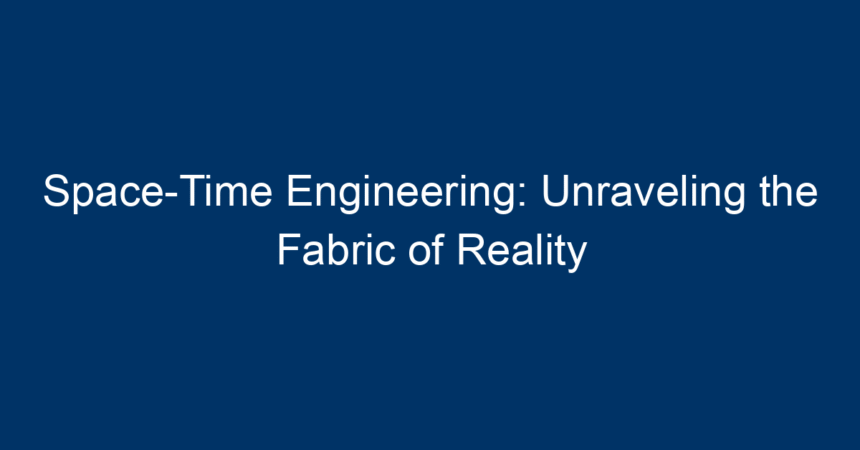Introduction
Imagine manipulating the very fabric of reality, bending time and space to our will. This thought, once confined to the realms of science fiction, has begun to inch nearer to our collective reality through the emerging field of space-time engineering. As we stand at the forefront of a new scientific revolution, it is essential to explore how space-time engineering fundamentally alters our perception of the universe. From the intricate dance of quantum mechanics to theories proposing the existence of parallel dimensions, space-time engineering promises to unravel mysteries that have captivated human imagination for centuries.
Neuroscientists, physicists, and engineers alike are inspired by the potential applications of space-time engineering. Not only could we redefine motion and travel, but we could also reshape industries, from telecommunications to transportation. In this article, we will delve into the foundational principles of space-time engineering, current research efforts, potential applications, and the ethical implications of such advancements.
Understanding Space-Time: A Quick Overview
Before we venture further into space-time engineering, let’s briefly revisit what space-time actually is. In physics, space-time combines the three dimensions of space with the dimension of time into a single four-dimensional continuum. Albert Einstein’s theory of relativity was revolutionary in demonstrating that gravity can warp this continuum, leading to phenomena such as time dilation.
The Fabric of Space-Time
The concept of space-time suggests that the universe is not a passive backdrop to events but an active participant that influences how those events unfold. For example, time moves slower near massive objects due to gravitational effects—an idea that has profound implications for our understanding of motion, causality, and the concept of simultaneity.
Theoretical Foundations of Space-Time Engineering
Quantum Mechanics and Space-Time
At the heart of space-time engineering lies quantum mechanics. This field explores the behavior of particles at the smallest scales and introduces radical ideas about the nature of reality. Concepts like wave-particle duality challenge our traditional understanding of physics.
Quantum Entanglement
One fascinating principle within quantum mechanics that could contribute to space-time engineering is quantum entanglement. When particles become entangled, the state of one particle instantly influences the state of another, no matter the distance separating them. This instantaneous communication has implications for real-time information transfer across vast distances, potentially paving the way for advanced communication systems that utilize space-time engineering.
The Role of General Relativity
General relativity complements quantum mechanics by providing a broader framework that describes how mass and energy influence space-time. This theory allows us to conceptualize warped space-time as a medium in which gravitational waves propagate, leading to exciting opportunities for engineer-based applications like gravitational wave detectors.
Current Research in Space-Time Engineering
The Quest for Faster-than-Light Travel
One of the primary focuses in the realm of space-time engineering is faster-than-light (FTL) travel. Theoretical constructs like wormholes and warp drives propose methods to traverse vast distances by bending space-time itself.
Wormholes: Shortcuts Through Space-Time
Wormholes are hypothetical tunnels through the fabric of space-time that could connect distant points. If stable wormholes can be created, they might allow for instantaneous travel between two vastly separated locations. However, these structures pose significant engineering challenges, including the need for negative energy to keep them open.
The Alcubierre Drive
Another pioneering concept is the Alcubierre drive, which envisions a spacecraft that could move faster than light by contracting space in front and expanding it behind, effectively creating a ‘wave’ in the fabric of space-time. Although purely theoretical at this point, advancements in space-time engineering could make such visions tangible.
Practical Applications of Space-Time Engineering
Telecommunications
Space-time engineering could revolutionize telecommunications by enabling ultra-fast data transmission that surpasses current technological limitations. This technology could shorten communication delays, making real-time interactions across vast distances feasible.
Improving Navigation Systems
With enhanced space-time models, our navigation frameworks could become profoundly more accurate. Space-time engineering could refine global positioning systems (GPS), allowing for more precise location tracking and route optimization.
Medical Applications
Space-time engineering could also have significant implications for medicine. For instance, utilizing quantum entanglement could lead to breakthroughs in medical imaging and real-time health monitoring, enabling more personalized and effective patient care.
Ethical Implications of Space-Time Engineering
With great power comes great responsibility. As we delve deeper into space-time engineering, ethical considerations must be at the forefront of our discussions.
The Risks of Manipulating Time and Space
The ability to manipulate space and time presents potential risks, including unintended consequences on the fabric of reality itself. For instance, altering time streams could lead to paradoxes, significantly affecting causality. Engaging in time travel could risk altering historical events, leading to a cascade of unforeseen consequences.
Equitable Access to Technology
Furthermore, technology developed through space-time engineering could exacerbate existing inequalities. It is crucial to ensure that advancements are accessible to all and do not become tools for further disenfranchisement.
Conclusion: Navigating the Future of Space-Time Engineering
The potential of space-time engineering to revolutionize our understanding of reality is awe-inspiring. As we navigate this exciting frontier, it is imperative to approach the subject with caution, awareness, and a commitment to ethical considerations.
As more researchers dive into this field, we can anticipate breakthroughs that may one day make faster-than-light travel, instant communication, and advanced medical technologies a reality. For those passionate about science, now is the time to engage in discussions surrounding space-time engineering and its myriad implications!
Let us foster a culture of inquiry and debate, encouraging new generations of thinkers to grasp the profound questions around space, time, and our shared universe. Whether you’re a scientist, a philosopher, or someone simply curious about the universe, it’s time to explore the limitless possibilities that space-time engineering presents!




